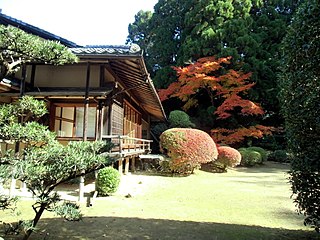
The Kokin Wakashū, commonly abbreviated as Kokinshū (古今集), is an early anthology of the waka form of Japanese poetry, dating from the Heian period. An imperial anthology, it was conceived by Emperor Uda and published by order of his son Emperor Daigo in about 905. Its finished form dates to c. 920, though according to several historical accounts the last poem was added to the collection in 914.

Ki no Tsurayuki was a Japanese author, poet and court noble of the Heian period. He is best known as the principal compiler of the Kokin Wakashū, also writing its Japanese Preface, and as a possible author of the Tosa Diary, although this was published anonymously. He is well known for his waka poetry and is counted as one of the Thirty-six Poetry Immortals selected by Fujiwara no Kintō; his poetry was included also in the Hyakunin Isshu. As a courtier, he served as Governor of Tosa (930-935), Vice Governor of Kaga (917-923) and Vice Governor of Mino Province (918-923).

Ariwara no Narihira was a Japanese courtier and waka poet of the early Heian period. He was named one of both the Six Poetic Geniuses and the Thirty-Six Poetic Geniuses, and one of his poems was included in the Ogura Hyakunin Isshu collection. He is also known as Zai Go-Chūjō, Zai Go, Zai Chūjō or Mukashi-Otoko.
This page is part of the List of years in poetry. The List of years in poetry and List of years in literature provide snapshots of developments in poetry and literature worldwide in a given year, decade or century, and allow easy access to a wide range of Wikipedia articles about movements, writers, works and developments in any timeframe. Please help to build these lists by adding and updating entries as you use them. You can access pages for individual years within the century through the navigational template at the bottom of this page, and you can access pages for other centuries through the navigational template to the right. To access the poetry pages by way of a single chart, please see the Centuries in poetry page or the List of years in poetry page.
Years link to corresponding "[year] in poetry" articles.

Fujiwara no Kintō, also known as Shijō-dainagon, was a Japanese poet, admired by his contemporaries and a court bureaucrat of the Heian period. His father was the regent Fujiwara no Yoritada and his son Fujiwara no Sadayori. An exemplary calligrapher and poet, he is mentioned in works by Murasaki Shikibu, Sei Shōnagon and in a number of other major chronicles and texts.

The Thirty-Six Immortals of Poetry are a group of Japanese poets of the Asuka, Nara, and Heian periods selected by Fujiwara no Kintō as exemplars of Japanese poetic ability. The oldest surviving collection of the 36 poets' works is Nishi Honganji Sanju-rokunin Kashu of 1113. Similar groups of Japanese poets include the Kamakura period Nyōbō Sanjūrokkasen (女房三十六歌仙), composed by court ladies exclusively, and the Chūko Sanjūrokkasen (中古三十六歌仙), or Thirty-Six Heian-era Immortals of Poetry, selected by Fujiwara no Norikane (1107–1165). This list superseded an older group called the Six Immortals of Poetry.

The Wakan Rōeishū is an anthology of Chinese poems and 31-syllable Japanese waka for singing to fixed melodies.
Nationality words link to articles with information on the nation's poetry or literature.
Nationality words link to articles with information on the nation's poetry or literature.

Waka is a type of poetry in classical Japanese literature. Although waka in modern Japanese is written as 和歌, in the past it was also written as 倭歌, and a variant name is yamato-uta (大和歌).
Heian literature or Chūko literature refers to Japanese literature of the Heian period, running from 794 to 1185. This article summarizes its history and development.

Yōmei Bunko (陽明文庫), located in Utanokaminotanicho, Ukyō-ku, Kyoto, is a historical archive containing approximately 100,000 objects collected over the centuries by the Konoe family, the foremost of the five regent houses of the imperial court nobility. The collection includes manuscripts, books, records, journals, letters, and antique works of art. In 1938, the Yōmei Bunko Foundation was established in its current location near Ninnaji Temple in northwest Kyoto by Fumimaro Konoe, then head of the family and prime minister of Japan. Materials preserved in the archive illustrate over 1,000 years of Japan's history, ranging from the "Midō Kanpaku-ki", the diary in his own hand of Fujiwara no Michinaga, one of the ancestors of the Konoe family, to 20th century materials relating to Fumimaro Konoe himself. The work of the archive includes making the collection available to researchers, conducting its own research, loaning items to exhibitions, and publishing facsimiles.
The Man'yōshū, an 8th-century Japanese anthology of waka, survives in a number of manuscripts dating to the 11th century and later.
The Katsura-bon (桂本) is the oldest extant copy of the Man'yōshū. It was produced around the middle of the Heian period, and is named for having formerly been in the possession of the Katsura-no-miya family.

Fujiwara no Sadanobu(藤原定信, 1088–1156) was a Heian period calligrapher. He is known primarily for his hiragana poetry transcriptions.

























